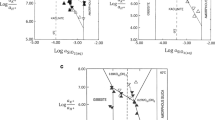Abstract
This paper presents a novel concept in the thermodynamic derivation of phase diagrams for clay minerals that incorporates fuzzy transition zones. This new technique yields phase diagrams that have graded (fuzzy) zones of mineral occurrences and includes compositional variability within mineral groups. For the construction of these diagrams, 170 minerals belonging to nine different subgroups were used, based on a fuzzy mathematical description of their ‘grades’ or ‘belonging-ness’. Standard free energies of formation of all the minerals were derived and all possible pairs of mineral equilibria were evaluated. Relative intensities of mineral occurrences were determined and membership values of each type of mineral at various zones in a 2D or 3D space were graphically represented. Computations and graphical representations were carried out using programs developed in Mathematica. Diagrams were derived for 25°C, 1 bar with a solution phase containing Si(OH)4, K+, Na+, H+, Ca2+ and Mg2+ under conditions of gibbsite, goethite and ferrous oxide saturation. The resulting diagrams, unlike conventional phase diagrams, show multimineral assemblages, with varying occurrences of different minerals and provide a realistic representation of clay mineral occurrences formed by surface geochemical processes. They show that on the Earth’s surface, only montmorillonite can almost completely predominate the inorganic phase followed by kaolinite, illite and beidellite. Nontronite, glauconite, celadonite and vermiculite would not be neoformed in substantial amounts. A general conformity of derived phase equilibria with experimentally observed equilibria is also observed.
Similar content being viewed by others
References
Aja, S.U., Rosenberg, P.E. and Kittrick, J.A. (1991) Illite equilibria in solutions: I. Phase relationships in the system K2O-Al2O3-SiO2-H2O between 25 and 250°C. Geochimica et Cosmochimica Acta, 55, 1353–1364.
Garrels, R.M. and Christ, C.L. (1965) Solutions, Minerals and Equilibria. Harper & Row, New York.
Helgeson, H.C., Brown, T.H. and Leeper, R.H. (1969) Handbook of Theoretical Activity Diagrams Depicting Chemical Equilibria in Geologic Systems Involving an Aqueous Phase at One Atm and 0° to 300°C. Freeman, Cooper & Company, San Francisco.
Johnson, J.W., Oelkers, E.H. and Helgeson, H.C. (1992) SUPCRT92: A software package for calculating the standard molal thermodynamic properties of minerals, gases, aqueous species, and reactions from 1 to 5000 bars and 0 to 1000°C. Computers and Geosciences, 18, 899–947.
Klir, G. and Yuan, B. (1997) Fuzzy Sets and Fuzzy Logic, Prentice-Hall, New Delhi.
Kudrat, M., Sharma, K.P., Varadachari, C. and Ghosh, K. (1999) An algorithm and program in C-language for computation of standard free energy of formation of clay minerals. Computers and Geosciences, 25, 241–250.
Kudrat, M., Varadachari, C. and Ghosh, K. (2000) Application of the improved regression method to derive \({\rm{\Delta G}}_{\rm{f}}^{\rm{0}}\) of non-stoichiometric clay minerals and their correlations with compositional parameters. Chemical Geology, 168, 225–238.
Norton, D. (1974) Chemical mass transfer in the Rio Tanama system, west-central Puerto Rico. Geochimica et Cosmochimica Acta, 38, 267–277.
Robie, R.A., Hemingway, B.S. and Fisher, J.R. (1978) Thermodynamic properties of minerals and related substances at 298.15°K and 1 bar (105 pascals) pressure and at higher temperature. US Geological Survey Bulletin, 1452, 1–456.
Tardy, Y. (1971) Characterisation of the principal weathering types by the geochemistry of waters from some European and African crystalline massifs. Chemical Geology, 7, 253–271.
Tardy, Y. and Duplay, J. (1994) Stability fields of smectites and illites including glauconites as a function of temperature and chemical composition. Pp. 95–132 in: Diagenesis IV (K.H. Wolf and G.V. Chilingarian, editors). Developments in Sedimentology, 51. Elsevier, Amsterdam.
Varadachari, C. (1992) Constructing phase diagrams for silicate minerals in equilibrium with an aqueous phase: A theoretical approach. Soil Science, 153, 5–12.
Varadachari, C. and Ghosh, K. (2003) Thermodynamic derivation of new low temperature phase diagrams for phyllosilicates defining stable and metastable phases. Indian Journal of Geology, 75, 203–217.
Varadachari, C. and Mukherjee, G. (2004) Discriminant analysis of clay mineral compositions. Clays and Clay Minerals, 52, 311–320.
Varadachari, C., Kudrat, M. and Ghosh, K. (1994) Evaluation of standard free energies of formation of clay minerals by an improved regression method. Clays and Clay Minerals, 42, 298–307.
Varadachari, C., Mukherjee, G., Goswami, D.P. and Chakraborty, M.K. (2003) Understanding clay minerals with fuzzy mathematics. Naturwissenschaften, 90, 44–48.
Author information
Authors and Affiliations
Corresponding author
Rights and permissions
About this article
Cite this article
Varadachari, C. Fuzzy phase diagrams of clay minerals. Clays Clay Miner. 54, 616–625 (2006). https://doi.org/10.1346/CCMN.2006.0540508
Received:
Revised:
Published:
Issue Date:
DOI: https://doi.org/10.1346/CCMN.2006.0540508




